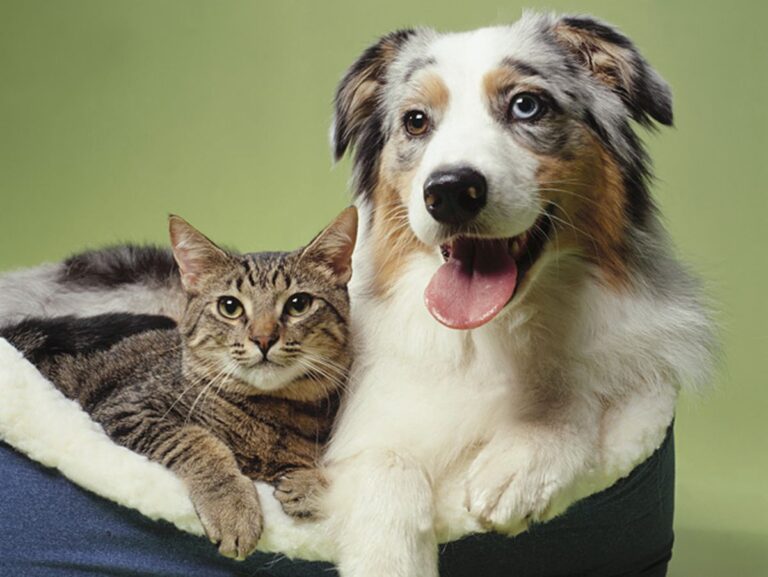Cats Vs Dogs - Nutrition

Can cats and dogs have the same diet? The question shouldn’t be whether they can but whether they should.
The following article will highlight few differences between dogs and cat’s digestive systems as well as provide you suggestions for what diets are most suitable for those animals.
Let us start with the first major difference between dog and cat nutrition is that the cats are carnivores, dogs are omnivorous.
Cats can take a long time to eat one meal, where dogs generally eat within few minutes.
Saying that however cats are known for coming to their meal a few times, their large meal can take them as many as 20 attempts – remember that we are also talking about large cats such as lions and tigers, however even pet cats prefer having their meal in parts.
Digestive Anatomy
There are no significant variations between cats and dogs digestive system anatomy, however, there are few differences in characteristics.
First of all length of the intestines. Cats’ intestines are shorter than those of a dog, latest research suggest that human evolved to be vegetarians due to their longer intestines (Dr. Justine Butler 2021), this would explain why dogs intestines are slightly longer (Omnivorous eat both meat and plants)
Oral Digestion
Our saliva produces an enzyme called amylase – which is responsible for the initiation of starch digestion in the mouth. https://media.lanecc.edu/users/powellt/FN225OER/Carbohydrates/FN225Carbohydrates4.html#:~:text=Some%20enzymatic%20digestion%20of%20starch,enzymatic%20digestion%20in%20the%20mouth.)
Cats and dogs lack that enzyme therefore their saliva differs from humans. This explains why dogs usually swallow their food in seconds with minimal chewing and a speed of light, and cats choose low starch diet (meat) (Burger, 1996) Cats and dogs have the same number of incisors and canines, but the differences in their dentitions are most evident by the lack of grinding molars in the cat, consistent with that of a true carnivore. The dog also has a greater total number of molars and premolars than the cat. Dogs therefore have 42 permanent teeth, whereas the cat only has 30. (Dr Guido Schroeder)
Stomach
Dogs tend to vomit quite often, this may be to the fact that their vomiting centre1 is well-developed.
This helps dogs to get rid of any unwanted toxins from their stomach – it’s a very good defence mechanism well known to us, humans, as well.
Cats as we all know also tend to vomit often – however most of the time they tend to get rid of the furballs – their vomiting centre isn’t as well developed as dogs and they don’t tend to like to vomit when feeling sick (not saying that they don’t if they need to)
Since the large intestine of the dog and the cat is not expected to digest polysaccharides, it is considerably shorter than in herbivores. The difference in caecum size between the dog and the cat has already been discussed. Ileo-caecal flow of water in the dog and cat is relatively high due to the low dry matter content of the ileal chyme (approximately 20%) (Burger, 1996). Residence time of undigested food residues in the large intestine is approximately 12 hours in the dog, with only 8% of total food digestion occurring in the large intestine. Due to the limited length of the canine’s large intestine, fibre fermentation is only ± 7-35%, while starch digestion varies from 15-100%, depending on the nature of the starch reaching the lower intestines.
Fat reaching the lower intestine is usually minimal, due to the efficient pre-caecal fat digestion in dogs and cats. This is a benefit considering fat inhibits bacterial fermentation. Sufficient levels of fibre in the dog and cat tends to prevent diarrheoa and constipation, with the normal water content of faeces being in the range of 65-75% (Burger, 1996). Bacterial fermentation and the presence of micro-organisms in the large intestine will be reserve for the section on pro- and prebiotics.
Other differences worth mentioning
Cats eyes are better adapted for hunting, their visual acuity is far more superior than that of the dogs (Kirk, Debraekeleer and Armstrong, 2000)
Cats and Dogs claws also differ. Where dogs claws only play a secondary role in capturing prey for cats retractable claws are very unique and important part of hunting.
I think it will come as no surprise when we mention that dog’s sense of smell is much better than that of a cat, however, some studies suggest that cats may be better at discerning between different smells, still dogs are capable of amazing things when it comes to their noses, with their 200-300 million olfactory receptors they are far more superior that cats (50 – 80 million)

Author: Michael Mendyka
1 – Part of brain that initiate and controls the act of emesis (vomiting)
References
BURGER, I.H., 1996. The Waltham Book of Companion Animal Nutrition. Butterworth – Heinemann, Oxford, UK.
JOHNSTON, K.L., 1996. Peculiarities of protein metabolism in the cat. Vetmed Profiles (Pet Nutrition) 9 (1):20-21.
KENDALL, P.T., Holme, D.W and Smith, Ph.M., 1982. Comparative evaluation of net digest and absorptive efficiency in dogs and cats fed a variety of contrasting diet types. J. Small Anim. Prac. 23:577.
KIRK, C.A., DEBRAEKELEER, J. and ARMSTRONG, P.J., 2000. Normal cats. Chapt. 11 In: Small Animal Clinical Nutrition, 4th Ed. Hand, M.S., Thatcher, C.D., Remillard, R.L., Rondebush, P., Morris, M.L. and Novotny, B.J. Mark Morris Institute, Walsworth Publishing Company Marceline, Missouri, USA.
LEWIS, L.D, MORRIS, M.L., HAND M.S., 1992. Small Animal Clinical Nutrition III. Morris & Ass.
MACDONALD, M.L., ROGERS, Q.R., MORRIS, J.G., 1984. Nutrition of the domestic cat, a mammalian carnivore. Annual Review of Nutrition 4:521-562.
MORRIS J.G., ROGERS, Q.R., 1991. Why is the nutrition of cats different to that of dogs? 64S-67S